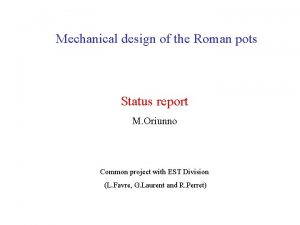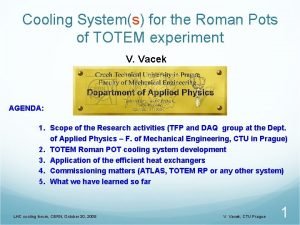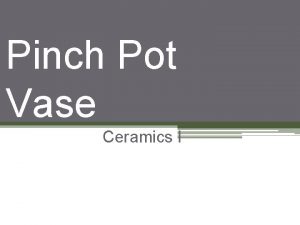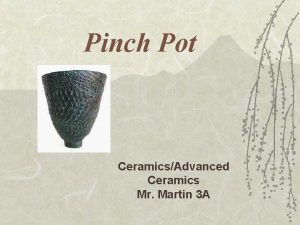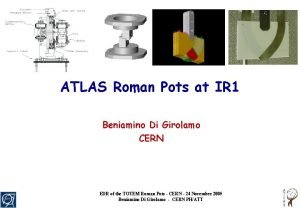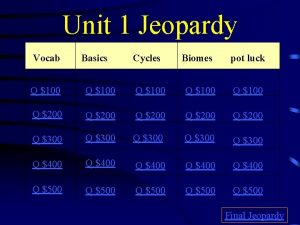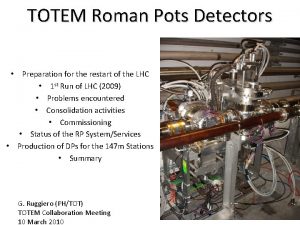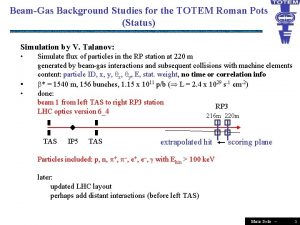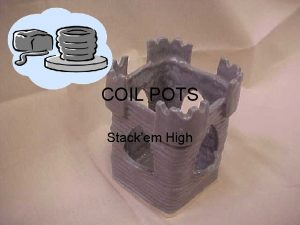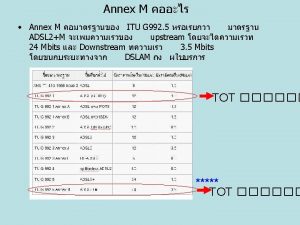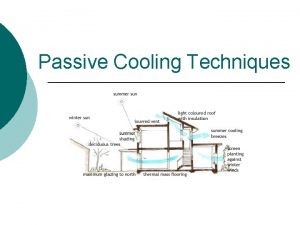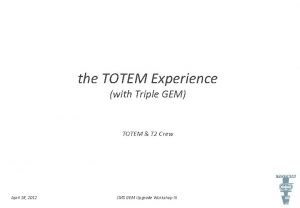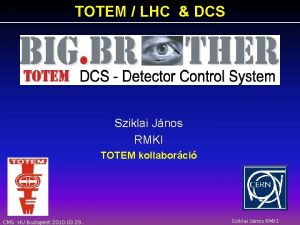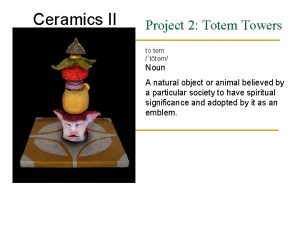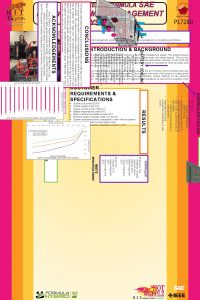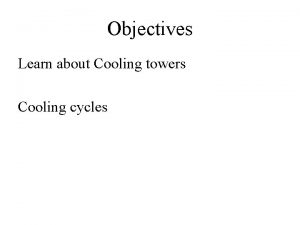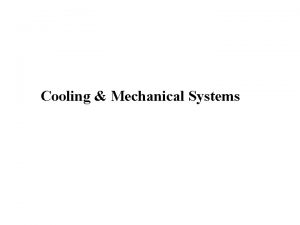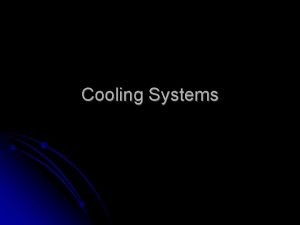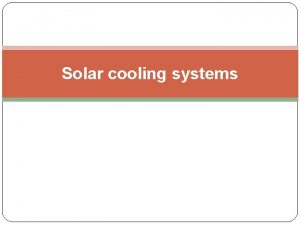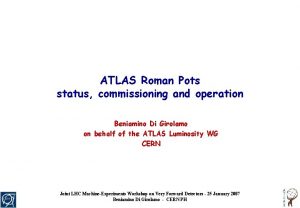Cooling Systems for the Roman Pots of TOTEM
























- Slides: 24

Cooling System(s) for the Roman Pots of TOTEM experiment V. Vacek AGENDA: 1. Scope of the Research activities (TFP and DAQ group at the Dept. of Applied Physics – F. of Mechanical Engineering, CTU in Prague) 2. TOTEM Roman POT cooling system development 3. Application of the efficient heat exchangers 4. Commissioning matters (ATLAS, TOTEM RP or any other system) 5. What we have learned so far LHC cooling forum, CERN, October 30, 2008 V. Vacek, CTU Prague 1

Scope of the Research activities over the last 10 years Main research program : Cooling system design for electronics application: ATLAS Inner Detector cooling circuit Pixel and SCT structures testing (with CPPM Marseille) Design, assembly and commissioning of the cooling system realized at CERN in SR 1 facility Commissioning measurements in the PIT (ATLAS cavern) TOTEM Cooling system for the Roman POTs Overall design, prototype development and verification of the Roman POT thermal mockup Commissioning measurements of the 24 RP, prior to the installation in the LHC tunnel; final system commissioning LHC cooling forum, CERN, October 30, 2008 V. Vacek, CTU Prague 2

Scope of the Research activities over the last 10 years Associated research program: Fluid property research: Thermophysical properties of fluoroinert fluids we studied, both theoretically (simulations – MD and MC methods) and experimentally Databases, individual thermophysical property fitting functions and engineering diagrams were prepared at the CTU for the most of the fluoroinert DAQ systems and various type of the sensors Mobile DAQ systems (based on ELMB and PVSS use) development and their implementation was completed Calibration and verification of the great variety of sensors was done Most of the commissioning measurements for ATLAS and TOTEM cooling systems were performed with our DAQ systems Heat transfer modeling for the heat exchangers design Two phase flow studies (capillary flow modeling) Cold box with controlled atmosphere for the AIRFLY project was developed and used during measurements (Frascati, It; Chicago, USA) LHC cooling forum, CERN, October 30, 2008 V. Vacek, CTU Prague 3

TOTEM Cooling system for the Roman POTs TOTEM Experiment - its main goal is to measure the total cross section, elastic scattering and diffractive processes at the LHC on both sides of the CMS detector. The diffractive processes are detected by two types of tracking telescopes (T 1 and T 2). To measure the cross section and the elastic and quasielastic interactions a special instrument had to be introduced: The Roman Pot (RP). 24 Roman Pots located in 8 positions around the beam pipes are capable of detecting particles diverted by extremely low angles Roman Pots LHC cooling forum, CERN, October 30, 2008 The inner structure of the Roman Pot consists of 10 silicon detectors, each of them is positioned in an electronic board called the “hybrid” with four embedded readout chips. Operation of the detectors requires temperatures below – 10 °C. The dissipated heat from the chips reaches ~ up to 3 W per plane. V. Vacek, CTU Prague 4

TOTEM Cooling system for the Roman POTs We have been asked to develop CS for TOTEM RP in MAY 2006, once the system based upon the heat pipes and pulse tube refrigerator has been ruled out since the changes in specs and strategy Our task was extremely difficult since we have inherited some fixed baselines, time for development was extremely short and nearly no resources were available at the beginning of the work A new system has been developed by the team of the CTU Prague and the final system for the PIT was designed and installed by TS/CV of CERN Close cooperation of the CTU and CERN - TS/CV resulted in successful commissioning of the whole system and it is still going on LHC cooling forum, CERN, October 30, 2008 V. Vacek, CTU Prague 5

TOTEM Cooling system for the Roman POTs An evaporative cooling system circulating fluorocarbon C 3 F 8 in 4 main closed loop has been chosen and designed to guarantee a total cooling capacity of 1. 2 k. W and supply a global mass flow rate of 40 g/s to be uniformly shared between the 24 TOTEM Roman Pots. Basic phases of the development: • Evaluation of the principle (2006 -2007) • Thermal mock-up development and testing (2007) • Small commissioning CS design and assembly for individual RP testing at H 8 facility at CERN was successfully finished in 2007/08 and is being used. IN PARALLEL: • Final CS has been designed by TS/CV (2007 -2008) • RP TOTEM CS is installed and being commissioned right now LHC cooling forum, CERN, October 30, 2008 V. Vacek, CTU Prague 6

TOTEM Cooling system for the Roman POTs • Evaluation of the principle (2006 -2007) • Thermal mock-up development and testing (2007) LHC cooling forum, CERN, October 30, 2008 V. Vacek, CTU Prague 7

Cooling Circuit in Building 887/H 8 - CERN The cooling has been designed, assembled and adjusted by the team from the Department of Applied Physics of the CTU in Prague in 2007 and 2008. It consists of two oil-free compressors, a set of chilled water heat exchangers, a pump and a condenser with PID controlled temperature. The circuit is filled with fluorinert refrigerant R 218. The circuit is presently prepared to cool down up to three Roman Pots simultaneously. Several tuning and control devices implemented within the circuit enable to vary a large scale of operational parameters. LHC cooling forum, CERN, October 30, 2008 V. Vacek, CTU Prague 8

Schematics of the Cooling Circuit with single POT DATE HEX LHC cooling forum, CERN, October 30, 2008 V. Vacek, CTU Prague 9

CTU Prague Performance of the Cooling Circuit with single POT LHC cooling forum, CERN, October 30, 2008 V. Vacek, CTU Prague 10

Success with elimination of the insulation = DATE-HEX provided to TOTEM and to us by TS/CV DATE-HEX is compact heat exchanger capable due to the enhanced heat transfer between liquid on one side and vapor on the other side. The device provide possibility to increase vapor temperature over the short distance and still keep pressure drop of vapor at relatively small values It could possibly, after modification and some more testing, replace „problematic“ heating elements-heaters in several applications elsewhere since the device does not require too complex control system and it can be considered as the self-tuning device LHC cooling forum, CERN, October 30, 2008 V. Vacek, CTU Prague 11

Implementation of the HEX into the cooling circuit Instrumentation around the HEX, P, T and flow sensors The Date–Hex prototype installed into the circuit with installed pipelines LHC cooling forum, CERN, October 30, 2008 Arrangement for the nominal refrigerant mass flow up to 5 g/s; water flow measured standard with use of float device, while vapor flow was monitored via SWISS-FLOW meters (frequency principle) calibrated prior to measurements V. Vacek, CTU Prague 12

Performance of the HEX LHC cooling forum, CERN, October 30, 2008 V. Vacek, CTU Prague 13

Performance of the HEX (other applications? ) LHC cooling forum, CERN, October 30, 2008 V. Vacek, CTU Prague 14

What is needed for smooth commissioning ? Reliable and robust DAQ system – it is a „must“ for the commissioning • Simple version of the mobile DAQ system for commissioning: • 64 channels (but expandable; low cost per channel) • Type of the sensors: • PT 100, PT 1000, NTC • Pressure sensors (voltage signals) Enhanced accuracy due to the „internal and „external ELMB calibration and proper sensor handling • Humidity sensors (capacitance principle+voltage converter) LHC cooling forum, CERN, October 30, 2008 V. Vacek, CTU Prague 15

ATLAS ID Cooling system commissioning DAQ system and PVSS project – well tested Type of sensors: NTC (kapton coated, pearl type); pressure sensors Huba and Sensortechnics (both HP and LP); mass flow meter Bronkhorst for the gas phase; 3 out of 6 available ELMB´s were used. All parts of the DAQ were verified and calibrated before the measurements. LHC cooling forum, CERN, October 30, 2008 V. Vacek, CTU Prague 16

TOTEM Cooling system commissioning Main problems in the case of TOTEM: • very often – some delays (both in hardware and software for the final system deliveries) • What had to be prepared in addition: • For the H 8 use • Multichannel DAQ and DCS system • For the PIT use • Several dummy loads – due to the final RP shifted delivery • Mini DAQ and DCS system for the PIT commissioning LHC cooling forum, CERN, October 30, 2008 V. Vacek, CTU Prague 17

CTU Prague Modifying and tuning Prevessin CS for commissioning purposes • Cooling System at H 8/in Building 887 prepared was prepared • DAQ and control system was verified and handed to TOTEM • Patch panel with valves has been added to the system to separate the rack for the Roman POT installed for eventual commissioning • Patch panel will allow: 1. an individual manipulation of the RP, 2. its leak checking 3. pumping down the separated part of the cooling lines • and when ready, • it can be connected to the CS circulation just through 2 valves LHC cooling forum, CERN, October 30, 2008 V. Vacek, CTU Prague 18

Prevessin CS – commissioning results of the RP No. 2 LHC cooling forum, CERN, October 30, 2008 V. Vacek, CTU Prague 19

Commissioning set up for single POT at H 8: Three POTs already commissioned Fluid INLET (liquid) and OUTLET (vapor) available Patch panel for an easy handling Environmental protection of the upper part solved Once upper part is connected (two tubes with refrigerant, electrical services and DAQ wires), RP is leak checked and pumped down, we can proceed with fast runs at H 8 installation Two major valves LHC cooling forum, CERN, October 30, 2008 V. Vacek, CTU Prague 20

Production of the dummy loads for the PIT and their verification at Prevessin LHC cooling forum, CERN, October 30, 2008 V. Vacek, CTU Prague 21

Production of the dummy loads for the PIT and their verification at Prevessin 1. Pressure drop verified 2. Leak tested 3. Electrical connection tested 4. Prepared for insulation 5. Installed within the final cooling plant Verified during the refrigerant circulation in the closed loops LHC cooling forum, CERN, October 30, 2008 V. Vacek, CTU Prague 22

Commissioning in the PIT: Roman Pot station in the LHC tunnel with one RP and two Dummy loads Sensors are monitored independently by the PLC and by the ELMB based mini DAQ system LHC cooling forum, CERN, October 30, 2008 Sumary of the last results from the PIT V. Vacek, CTU Prague 23

SUMMARY Overall scope of the research activities was outlined – covering last few years Activity within the ATLAS ID cooling system development were mentioned TOTEM Roman POT cooling system was described and relevant experience from CS design, running and commissioning were presented Heat exchanger use for the efficient vapor warm up was described and experimental results were introduced General comments related to CS of the RP detector applications were introduced LHC cooling forum, CERN, October 30, 2008 V. Vacek, CTU Prague 24
 Roman pots
Roman pots Roman cooling system
Roman cooling system Ebullient cooling systems
Ebullient cooling systems Advanced cooling systems inc
Advanced cooling systems inc Pinch pots
Pinch pots History of pinch pots
History of pinch pots In a kitchen, pots with handles that are loose:
In a kitchen, pots with handles that are loose: Keep pots clean or family gets sick
Keep pots clean or family gets sick Mcas rds
Mcas rds Double pinch pot
Double pinch pot Ko pots
Ko pots Bear pinch pot
Bear pinch pot Hip effusion
Hip effusion Chapter 2 speaking mathematically
Chapter 2 speaking mathematically My favourite animal is panda
My favourite animal is panda Pinch pots history
Pinch pots history Pinch pot ceramics definition
Pinch pot ceramics definition Masuso pot
Masuso pot Natflave
Natflave Schrijver dummie de mummie
Schrijver dummie de mummie Greek coil pots
Greek coil pots Rewriting a universal existential statement example
Rewriting a universal existential statement example Ir pots
Ir pots Biomesb
Biomesb Pots and pans restaurant tyler texas
Pots and pans restaurant tyler texas
